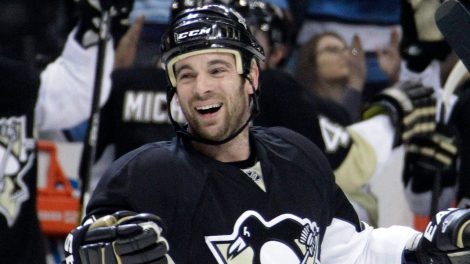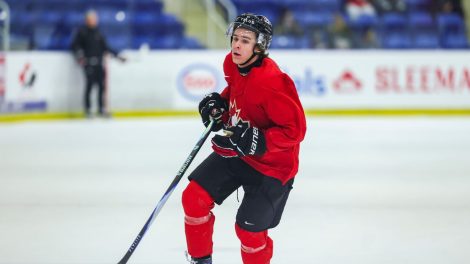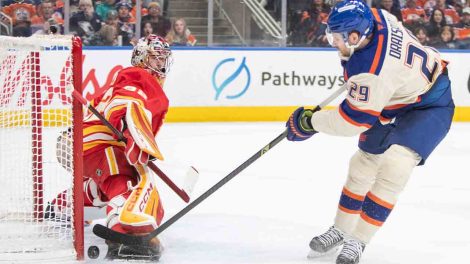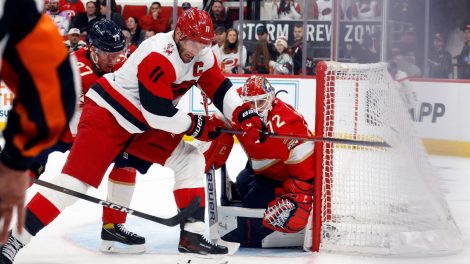Last season the top of the Pacific Division was arguably the toughest area of the NHL. The Calgary Flames, Vegas Golden Knights and San Jose Sharks were three of the best teams across all kinds of metrics.
Raise your hand if you expected the top two teams in that division through one month of this season to be the Edmonton Oilers and Vancouver Canucks.
Now put your hands down you liars.
Even the most diehard, optimistic fans of either team weren’t going to put money on the line that these two Western Canadian team, subjects of criticism and mockery for years, would get off to such great starts.
A lot of the focus has been on the Oilers and for good reason. Because of their two stars Connor McDavid and Leon Draisaitl, every Edmonton game has become appointment viewing.
But go further west and there’s not as much attention being paid to Elias Pettersson and his ability to take over games.
That should change.
[snippet id=4167285]
SPOTLIGHT PERFORMANCE
Last season Pettersson got a lot of credit for his two-way play — he was clearly more involved and more intelligent in his defensive reads than the average rookie. But the off-season acquisition of J.T. Miller has really moved the needle for both Pettersson and the Canucks.
Among Vancouver skaters with 700 or more minutes played last season, Pettersson was easily the biggest possession driver. But because the Canucks were so bad overall, he was barely above even in on-ice shot attempts, and below even in shots and high danger chances.
So far this season, things are vastly different.

Pettersson and Miller are leading the Canucks in those on-ice differentials this year, but instead of brilliant play barely leading to positive differentials at all, both players are close to or at controlling 60 per cent of play. That’s absurd, and on par with the best lines in the NHL from last season. It’s the kind of thing that can unilaterally change a team’s fortunes in the short term.
There’s a trickle-down effect on teams when they add good players. Everyone else is given a role more suited to their talent level and that has led to lots of positive change for the Canucks. Even without Pettersson on the ice now they’ve improved this season by five percentage points in inner slot differential — from 43.5 per cent to 48.9 per cent — and one to two percentage point increases in shots, shot attempts, and slot passes.
With Pettersson and Miller on the ice that impact is even greater. Those two together are bringing the Canucks’ overall differentials at 5-on-5 to 52.4 per cent (+8.9% over last season) from the inner slot, 53.2 per cent (+5.8%) in shots, 52.1 per cent (+4.1%) in shot attempts, and 48.9 per cent (+5.8%) in passes to the slot.
Things aren’t perfect in Vancouver — there are still some defensive issues in terms of their slot pass prevention — and they’re a very top-heavy team. But overall this start has them looking legit, which is something we haven’t been able to say about the Canucks in a very long time.
[snippet ID=3322139]
THE QUESTION
This week Steve wanted to know what’s going on in Newark, since so many were convinced their off-season moves were so positive, but it hasn’t really gone that way.
“The Devils were a carnival with bad goaltending last year. They made wild changes in the summer, mostly additions. They’re still blowing leads every game. Is this team actually improved, but with bad goaltending, or has nothing changed?”
A couple years ago when the Devils made the playoffs, I think it gave some people a false expectation of where they were in their rebuild. I’m not sure it’s fair to say the Devils’ management is in that boat, but the additions made in the summer, while good, just weren’t enough to make the impact some were expecting.
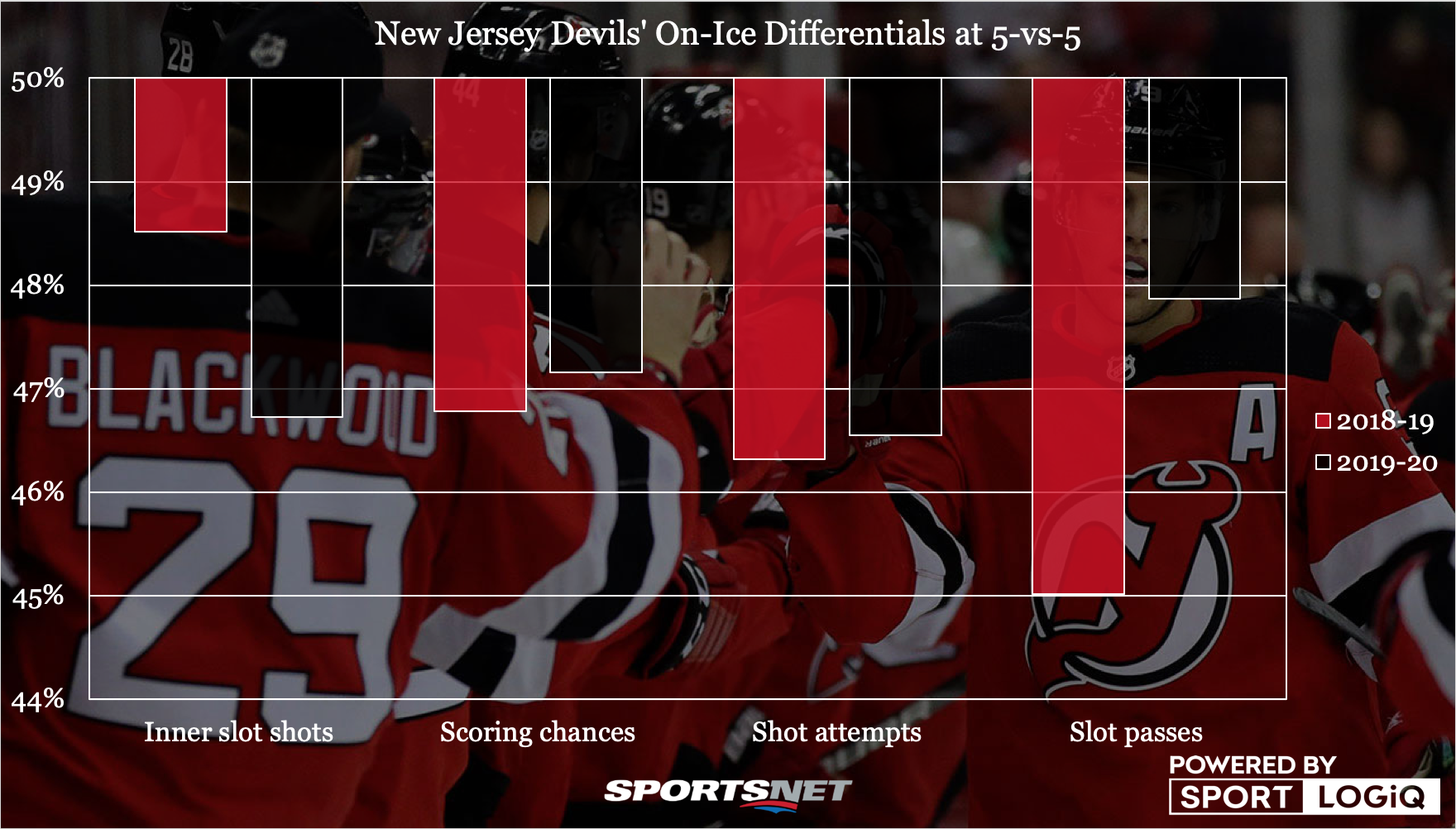
Comparing this season’s Devils to last season, they’ve improved their scoring chance and shot attempt differentials by a little bit, and improved their pass to the slot differential by a lot. Those improvements have come entirely on the defensive side of the puck, which is a bit of a surprise considering Jack Hughes is a rookie, Wayne Simmonds has never been known for his defensive impact, and P.K. Subban has had a rough start defensively to say the least.
The elephant in the room here is that while it appears the Devils have improved in several areas, they’re actually worse in shots from the inner slot, which is a bit of a problem.
Small samples can make this stat look more extreme than it really is though, and an extra three shots from that area would bring New Jersey back in line with what they did last season, so I’m not sure it’s a huge deal yet.
Part of the issue here is that the Devils were a very bad team last year, and improvements that may seem large aren’t going to be enough to immediately turn things all the way around. But another issue is that they’ve been devastatingly unlucky in a variety of ways.
Colour me shocked after the decline he’s experienced in recent seasons, but Simmonds has been unreal so far. The Devils are controlling 65.5 per cent of high danger chances when he’s on the ice and no Devil has been more involved in creating scoring chances. Simmonds is in on 9.18 scoring chances per 20 minutes, while only Nico Hischier has fired more pucks at the net from the slot. And yet Simmonds has been held goalless so far. He has four assists — three of which came in his most recent game.
A three-assist game might be an inkling of things to come for him though. He’s really earned a better start than he’s had. The Devils should be better than last year, especially defensively, but they’re still in need of some serious improvements.
[snippet id=3816507]
BUY OR SELL
• Two weeks ago I mentioned Subban was off to a very rough start defensively and one of the reasons for that has been a drop in his neutral zone defence. Last season 47.4 per cent of attempted entries against Subban were denied and teams failed to record a scoring chance on 72.3 per cent of successful entries against him. This season those numbers are down to 27.5 per cent denied, and teams are only failing to get a scoring chance 60.8 per cent of the time. With that said, he’s cut down scoring chances against and gone from team-worst to team-average, so things are getting better.
• Since we updated on Subban, let’s look at Shea Weber as well. Like Subban, Weber has brought his high danger scoring chances against down from team worst to team average, but he’s struggling in a totally different area. While Subban was struggling in the neutral zone, Weber has been better in the neutral zone than last season, but has really struggled with in-zone coverage. Neither player is in ‘playing well’ territory yet, but both are getting better.
• Sticking with the Canadiens for a second, let’s talk about Brett Kulak. He seems to get taken out of the lineup for every mistake, but Kulak has the highest entry denial rate on the Canadiens at 71.4 per cent, and trails only Jeff Petry in high danger chance differential. The guy is really good. It’s very strange how little respect he gets.
• The shift to a more offensive style in Nashville has been fun to watch and no one is benefiting more than Filip Forsberg. Only Sidney Crosby has been involved in more than Forsberg’s 10.5 scoring chances created per 20 minutes at 5-on-5, and only Brendan Gallagher, Tyler Toffoli, and Alex Ovechkin are getting more scoring chances on net. Forsberg must love Matt Duchene.
• I wondered earlier if the Oilers could sustain their strong defensive play: so far so good. Only the Dallas Stars are giving up fewer high danger scoring chances, and only the Stars and Predators are giving up fewer chances overall. If the Oilers can cut down on passes to the slot, where they give up the 10th-most per minute, they’re going to surprise a lot of people.
[relatedlinks]

